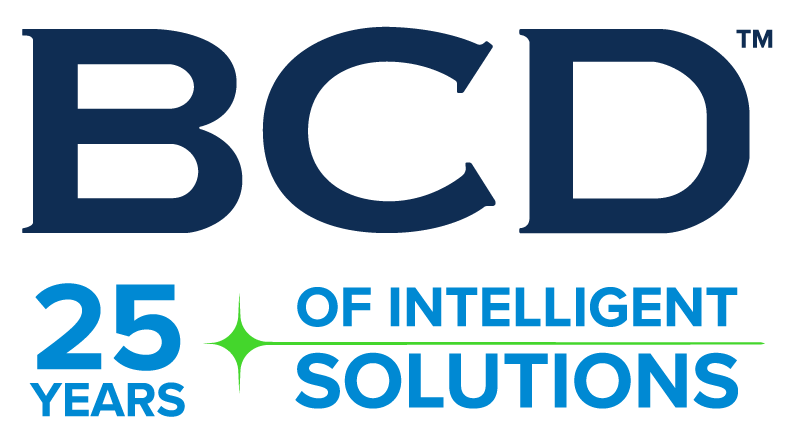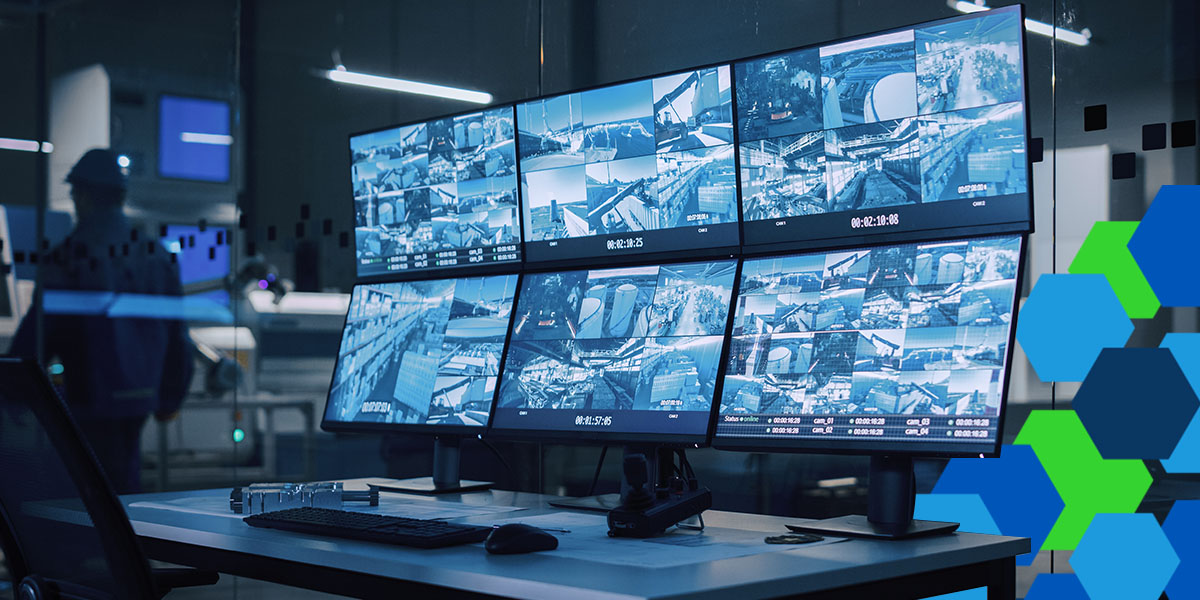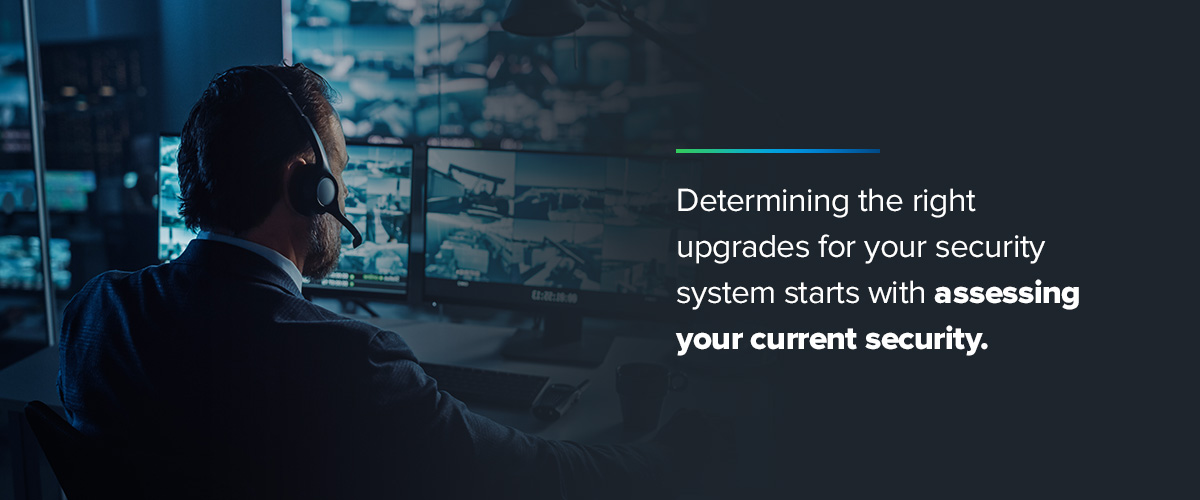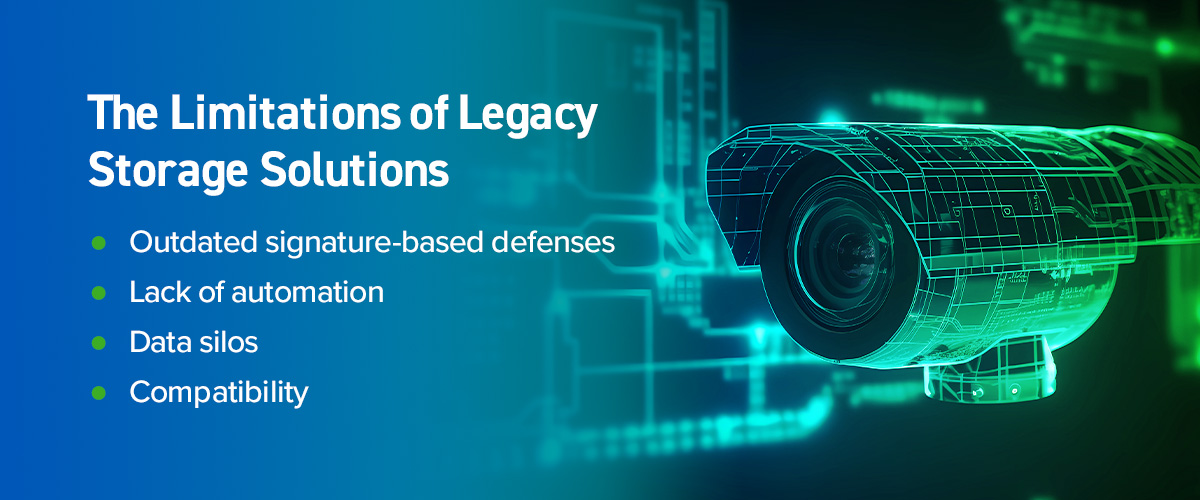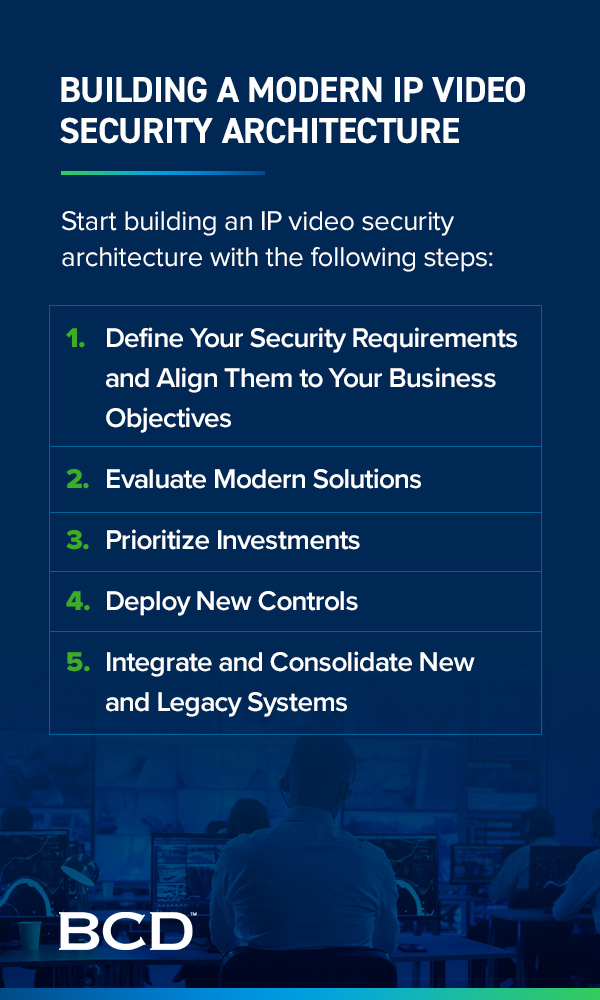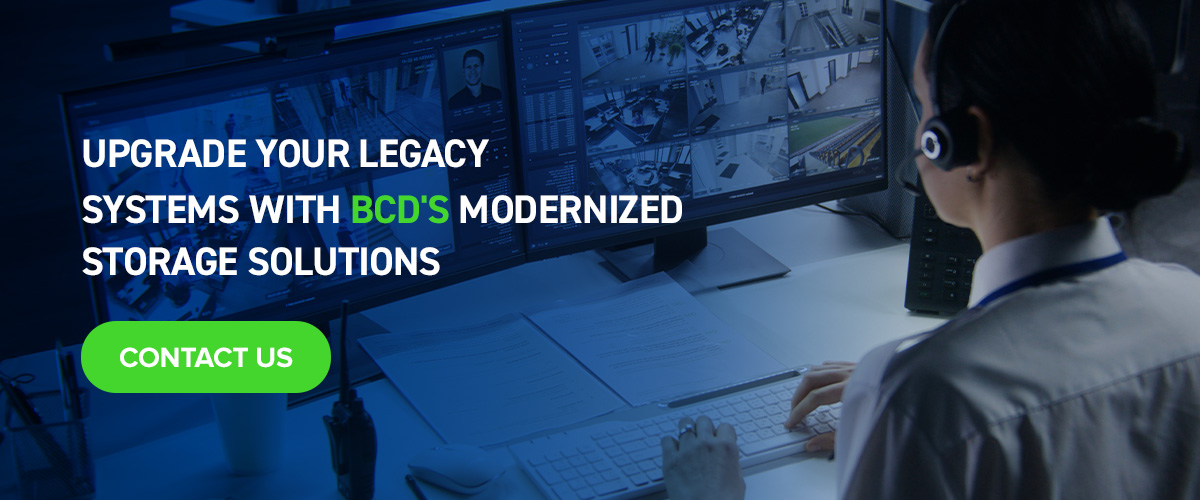The changing security landscape presents many opportunities, but managing video surveillance data throughout its lifecycle has become increasingly complex. Modernizing and upgrading video surveillance deployments is essential to defend against evolving threats. Legacy solutions often lack the capabilities to address today’s attack methods, making a modern security architecture more critical than ever.
Security is a priority for many organizations, and regular security assessments and upgrades can mean the difference between a success and an expensive lesson.
Why Upgrading Security Technology Is Important
Security should be flexible and comprehensive, allowing you to take the necessary measures to secure your property, staff and assets.
Modern security technologies integrate physical and digital security to add dynamic layers to your overall security profile. Hardware and software each play a role in creating an integrated system purpose-built to protect your assets. The demand for video surveillance expands every year. Many businesses upgrade their technology to stay ahead of evolving threats.
Some of the principal benefits of upgrading your security technology include:
- Reduced costs: Upgrades may involve an upfront investment, but innovative security technology is multifaceted. It provides data you can leverage to inform future security efforts and works to mitigate the damage caused by threats and disasters.
- Minimal staff shifts: Modern surveillance and access control systems eliminate the need for security personnel on-site. Security professionals can monitor entire buildings from one location, cutting labor costs and providing a more holistic picture.
- Enhanced protection: Your staff and assets represent a significant investment. As criminals use more creative methods to try and gain access, upgrading is essential to avoid malicious access attempts.
- Increased property value: Properties with intelligent security devices see increases in resale value, rental rates and net operating income.
- Maintained trust and confidence: When your stakeholders know you make every effort to protect your assets, it increases trust in your business operations and improves your reputation.
Assessing Your Current Security Posture
Determining the right upgrades for your security system starts with assessing your current security. A security posture assessment measures your organization’s overall security status, including network, information, data, awareness training, surveillance, access management and more. It’s an in-depth examination of your internal and external security controls and dictates how you defend yourself and respond to threats. A thorough assessment of your current security posture includes:
Conducting Audits and Risk Assessments
Conducting audits and risk assessments gives detailed insights into your security posture so you can take steps to identify and address weaknesses. A typical risk assessment includes:
- Asset mapping: Generate a complete map of vulnerable assets, including hardware, users and data storage. You should log and track each asset in one central database.
- Threat and vulnerability identification: Identify vulnerabilities and potential threats for each asset.
- Risk determination: Once you have identified all the risks, you can give each vulnerability a rating to focus your efforts on the most vulnerable areas.
- Gap identification: Test exposure areas and identify gaps in detection, prevention and response based on your unique organizational requirements.
- Testing modern attack types: Use your legacy system against modern attack types to identify weaknesses.
Once you know the discrepancies between your current security posture and modern threats, you can identify solutions that connect every aspect of your security environment, such as remote monitoring and management (RMM) plug-ins. The Harmonize RMM plug-in simplifies monitoring and managing your video surveillance systems with custom telemetry to maximize uptime and give you confidence that your assets are protected.
Aligning With Industry Standards
Many industries require security systems to align with existing standards and security frameworks — sets of documented processes that define policies and procedures around the implementation, monitoring and management of security controls. They provide a robust starting point for establishing strategies, policies and administrative activities for effective security management.
Security frameworks are varied in scale and complexity. You can choose from many security frameworks depending on your needs and compliance requirements, some of which include:
- National Institute of Standards and Technology (NIST): NIST has developed an extensive library of security standards, from IT security to cloud and cybersecurity.
- Center for Internet Security (CIS) controls: CIS critical security controls list technical security and operation controls that can be applied to any environment. Unlike NIST frameworks, CIS controls focus on risk reduction instead of risk management.
- International Organization for Standardization (ISO) 2700 series: This collection of security standards create a flexible information security framework that can be scaled to all types and sizes of organization.
The Limitations of Legacy Storage Solutions
Legacy video storage systems have limitations in meeting today’s threat landscape. Video surveillance data is helpful for more than security — many organizations leverage video analytics to analyze behavior and predict and prevent security incidents. These additional requirements strain legacy systems further, causing compatibility issues and placing strain on an already limited setup.
Some of the principal limitations of legacy video storage solutions include:
- Outdated signature-based defenses: These defenses are used against known attacks or vulnerabilities. Signature-based defenses become ineffective as the security landscape changes and more advanced threats arise.
- Lack of automation: Technological advancements make systems faster every year. Lack of automation in legacy systems increases incident response time and creates considerable workloads for analysts.
- Data silos: Siloed data is stored in standalone systems and is often incompatible with other data sets. Effective security means total visibility of the attack surface. Data silos provide partial visibility, leaving vulnerabilities open.
- Compatibility: As your organization adopts new technologies, lack of compatibility becomes a significant problem. When the elements of your system cannot communicate, your legacy system may not receive patching updates. Support from in-house experts and manufacturers becomes scarce. Criminals are quick to identify these vulnerabilities, placing your operations at risk.
The Key Capabilities of Modern Video Storage Systems
Many of the key capabilities of modern security systems grew from weaknesses in their predecessors. Modern video surveillance infrastructure and data retention capabilities are critical for business intelligence. The latest video management system (VMS) software offers significant benefits for security executives, supporting the deployment of larger cameras and expanding system capabilities.
Innovative security systems have the following capabilities:
- Service centralization: A centralized platform can transform enterprise security management, and integrated systems maximize your security team’s value by eliminating inefficiencies in their daily operations.
- Artificial intelligence (AI) and machine learning: Utilizing AI enhances threat detection and analysis through accuracy and efficiency, reducing false alarms and increasing operational effectiveness. Advanced facial and object recognition and behavior analysis improve video analytic capabilities. AI and machine learning can simplify installation and configuration, enabling fast project turnaround and rapid system readiness.
- Automation: Security automation leverages technology to perform recurring security tasks, such as endpoint scanning and incident response. It allows teams to perform routine tasks more effectively with limited human intervention. Automation can improve threat detection, enhance containment, accelerate investigation and streamline remediation workflows. It optimizes the workforce and frees security staff to focus on high-priority work.
- Cloud-native and application programming interface (API)-based integration: Using cloud infrastructure and leveraging specific APIs integrates various physical security systems like video surveillance and access control with other applications, centralizing management and simplifying real-time monitoring.
- Consolidated visibility through XDR and SIEM systems: Extended detection and response (XDR) and security information and event management (SIEM) systems can work together to give users a single view of the security landscape. Seeing all the security elements in one place supports robust detection and response.
- Proactive threat-hunting capabilities: Modern security systems can identify triggers that point to possible entry. When the trigger is activated, it directs threat hunters to the specific location of the irregularity and provides information on the extent of the threat. Proactive threat hunting results in a better understanding of weaknesses following an attack, so you can develop more robust security measures to prevent recurrences.
Building a Modern IP Video Security Architecture
Upgrading video security systems is critical to modernizing your security architecture. Modern systems integrate hardware and software and equip cameras with cloud and computer vision capabilities. Keeping clients’ assets secure is essential to running a business. Start building an IP video security architecture with the following steps:
1. Define Your Security Requirements and Align Them to Your Business Objectives
A client’s needs depend on several factors, including assets, building size and storage infrastructure. The first step to building your security architecture is to identify and align these requirements to your business goals. For example, if your business goal for the next year is rapid growth, one of your security requirements is rapid system scalability.
Video workloads differ from those in IT, particularly when you start processing hot data. An effective video security architecture must be purpose-built to address each security environment’s needs. Consider each security environment and requirements, such as high camera counts, data security or operational flexibility. Each requirement presents challenges, including:
- Security cameras: Modern, high-megapixel security cameras provide high-quality video for several applications. The volume of storage creates challenges for security professionals. Your available bandwidth can impact video clarity and transferring speeds, which renders your system obsolete. Data storage is essential to limit dropped frames and lost data, completing your modern security solution.
- Access control: Your approach to access control should cover physical and resource access. Whatever your security architecture, you must be able to back it up — and integrate — the most robust data security measures.
- Video analytics: Your security workflows dictate your requirements, such as whether you require hot data processing on the front end and high-quality data storage on the back. Video analytics software can transform your operation with options like facial and license plate recognition and object tracking.
- VMS: Your VMS controls the quality of the video delivery workstation, the reliability of your servers and the switches for your IP surveillance systems. Ensure you select the right VMS for your needs. It provides a central location for all of your modern technologies.
2. Evaluate Modern Solutions
You have already identified gaps in your current system during the assessment phase, and these form your priorities as you build your architecture. Consider the following factors when evaluating potential solutions:
- Performance: Your system’s performance can impact video quality, regardless of your camera choice. Ensure your system has unlimited processing capacity and that storage solutions are not restricted to what you have on-site.
- Scalability: Whether you plan to expand to more locations, adjust the amount of storage or add cameras, ensure your modern network security architecture is scalable to account for business growth and compliance requirements.
- Data security: Your solution should prioritize data security to mitigate the risks of connecting individual cameras to the cloud. Look for on-premises gateways that let you connect all your cameras to a single point, creating one source of vulnerability instead of securing individual cameras.
- User experience: Your system should be intuitive and easy to use, centralizing your data and eliminating silos for a bird’s eye view of your entire security architecture.
3. Prioritize Investments
Replacing a legacy system with a modern one can require a significant investment. In many ways, gradual integration is easier to manage financially and operationally. Focus on your high-risk areas and use cases in the initial stages of your upgrade, addressing critical vulnerabilities before moving on to secondary areas.
4. Deploy New Controls
Deploying your new controls in stages has significant benefits. It’s easier for your team to train on the new system and integrate it into their workflow. The technology adoption rate is faster when you eliminate friction from the user experience. Giving your team time to learn the new operating protocols also ensures they maximize the technology, providing a better return on investment.
Phasing your deployment also gives you space to identify and address opportunities for improvement in stages so your upgrade runs smoothly when complete.
5. Integrate and Consolidate New and Legacy Systems
Your legacy and modern systems must work together to maintain visibility throughout your security architecture. Your system design must consider how users interact with your current systems and gather feedback from users and stakeholders to create a seamless transition.
Test your system integration before launching to ensure each component works and allow users to sample the improvements and make recommendations to streamline their workflows.
Challenges and Considerations for Security Deployment Upgrades
When you deploy an upgrade, you’re likely to encounter challenges. Consider the following to streamline your deployment:
- Training: Ensure your security team and end users have ample training on new solutions and processes. They can only leverage modern technology if they know how it works.
- Building proficiency: While training provides the basics, your team should be able to navigate security deployment upgrades as part of their workflow. It should be second nature, which means they need to build proficiency. You can achieve this goal through testing end exercises centered around the practical use of the new additions.
- Developing policies and procedures: Your existing policies and procedures may become obsolete as you deploy your security upgrades. Having a current and relevant security policy outlining acceptable practices is essential. Make it easy for people to adhere to your policies and procedures by keeping them reasonable, auditable, enforceable and measurable.
- Budgeting: Sticking to a budget can be challenging when you require advanced capabilities. Ensure you create an accurate budget that includes any licensing fees for integrating new technology.
- Maintaining legacy systems: Downtime is a significant challenge when modernizing your security systems. By leveraging robust hybrid data storage solutions like BCD Harmonize Bridge, powered by Tiger Technologies, you can address this obstacle. This solution provides seamless cloud storage and services management while maintaining legacy applications and workflows to minimize downtime.
Upgrade Your Legacy Systems with BCD’s Modernized Storage Solutions
Upgrading your security to incorporate modern solutions has significant benefits, including service centralization, automation and consolidated visibility. Threats continue to evolve, making agile systems and continuous assessment essential. A proactive posture reduces risk across your organization and keeps you ahead in a rapidly changing landscape.
Our BCD experts are here to create and maintain a modern security solution aligned with current threats. Our solutions can transform your security and data storage. The Harmonize RMM plug-in lets you connect every security element into a centralized hub, monitoring cameras, available storage, server temperatures and more. BDC Harmonize Bridge can create a hybrid security environment, leveraging modern and legacy systems for a frictionless transition. Contact us to learn more or schedule a demo and experience our solutions firsthand.
